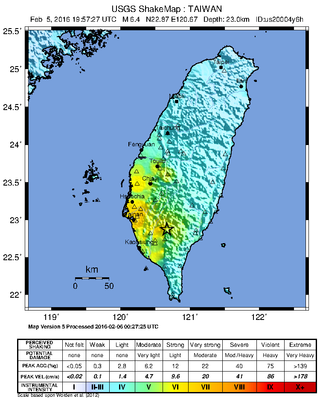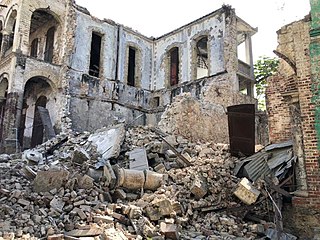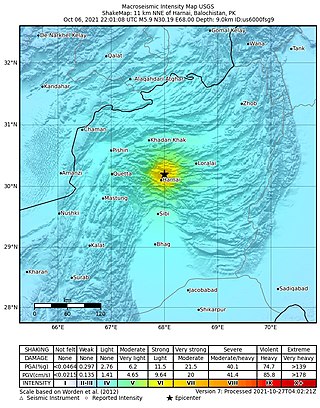A mining accident is an accident that occurs during the process of mining minerals or metals. Thousands of miners die from mining accidents each year, especially from underground coal mining, although accidents also occur in hard rock mining. Coal mining is considered much more hazardous than hard rock mining due to flat-lying rock strata, generally incompetent rock, the presence of methane gas, and coal dust. Most of the deaths these days occur in developing countries, and rural parts of developed countries where safety measures are not practiced as fully. A mining disaster is an incident where there are five or more fatalities.

The 1985 Mexico City earthquake struck in the early morning of 19 September at 07:17:50 (CST) with a moment magnitude of 8.0 and a maximal Mercalli intensity of IX (Violent). The event caused serious damage to the Greater Mexico City area and the deaths of at least 5,000 people. The sequence of events included a foreshock of magnitude 5.2 that occurred the prior May, the main shock on 19 September, and two large aftershocks. The first of these occurred on 20 September with a magnitude of 7.5 and the second occurred seven months later on 30 April 1986 with a magnitude of 7.0. They were located off the coast along the Middle America Trench, more than 350 kilometres (220 mi) away, but the city suffered major damage due to its large magnitude and the ancient lake bed on which Mexico City sits. The event caused between three and five billion USD in damage as 412 buildings collapsed and another 3,124 were seriously damaged in the city.

The 1990 Luzon earthquake occurred on July 16 at 4:26 p.m. (PDT) or 3:26 p.m. (PST) on the densely populated island of Luzon in the Philippines. The shock had a surface wave magnitude of 7.8 and produced a 125 km-long ground rupture that stretched from Dingalan, Aurora to Kayapa, Nueva Vizcaya. The event was a result of strike-slip movements along the Philippine Fault and the Digdig Fault within the Philippine Fault System. The earthquake's epicenter was near the town of Rizal, Nueva Ecija, northeast of Cabanatuan. An estimated 1,621 people were killed, most of the fatalities located in Central Luzon and the Cordillera region.

The 1960 Agadir earthquake occurred on 29 February at 23:40:18 Western European Time near the city of Agadir, located in western Morocco on the shore of the Atlantic Ocean. Despite the earthquake's moderate scale magnitude of 5.8, its relatively shallow depth (15.0 km) resulted in strong surface shaking, with a maximum perceived intensity of X (Extreme) on the Mercalli intensity scale. Between 12,000 and 15,000 people were killed and another 12,000 injured with at least 35,000 people left homeless, making it the most destructive and deadliest earthquake in Moroccan history. Particularly hard hit were Founty, the Kasbah, Yachech/Ihchach and the Talborjt area. The earthquake's shallow focus, close proximity to the port city of Agadir, and unsatisfactory construction methods were all reasons declared by earthquake engineers and seismologists as to why it was so destructive.

An earthquake struck the Kerman province of southeastern Iran at 01:56 UTC on December 26, 2003. The shock had a moment magnitude of 6.6 and a maximum Mercalli intensity of IX (Violent). The earthquake was particularly destructive in Bam, with the death toll amounting to at least 34,000 people and injuring up to 200,000. The effects of the earthquake were exacerbated by the use of mud brick as the standard construction medium; many of the area's structures did not comply with earthquake regulations set in 1989.
The 2003 Boumerdès earthquake occurred on May 21 at in northern Algeria. The shock had a moment magnitude of 6.8 and a maximum Mercalli intensity of X (Extreme). The epicentre of the earthquake was located near the town of Thénia in Boumerdès Province, approximately 60 km east of the capital Algiers. The quake was the strongest to hit Algeria in more than twenty years – since 1980, when a magnitude 7.1 earthquake resulted in at least 2,633 deaths.
The 2002 Bou'in-Zahra earthquake occurred on 22 June 2002. The epicenter was near the city of Bou'in-Zahra in Qazvin Province, a region of northwestern Iran which is crossed by several major faults that is known for destructive earthquakes. The shock measured 6.5 on the scale, had a maximum Mercalli intensity of VIII (Severe), and was followed by more than 20 aftershocks. At least 230 people were killed and 1,500 more were injured.
The Qayen earthquake, also known as the Ardekul or Qaen earthquake, struck northern Iran's Khorasan Province in the vicinity of Qaen on May 10, 1997, at 07:57 UTC. The largest in the area since 1990, the earthquake registered 7.3 on the moment magnitude scale and was centered approximately 270 kilometers (170 mi) south of Mashhad on the village of Ardekul. The third earthquake that year to cause severe damage, it devastated the Birjand–Qayen region, killing 1,567 and injuring more than 2,300. The earthquake—which left 50,000 homeless and damaged or destroyed over 15,000 homes—was described as the deadliest of 1997 by the United States Geological Survey. Some 155 aftershocks caused further destruction and drove away survivors. The earthquake was later discovered to have been caused by a rupture along a fault that runs underneath the Iran–Afghanistan border.
The Chi-Chi earthquake, was a 7.3 ML or 7.7 Mw earthquake which occurred in Jiji (Chi-Chi), Nantou County, Taiwan on 21 September 1999 at 01:47:12 local time. 2,415 people were killed, 11,305 injured, and NT$300 billion worth of damage was done. It is the second-deadliest earthquake in Taiwan's recorded history, after the 1935 Shinchiku-Taichū earthquake.

The first of the 2009 Sumatra earthquakes occurred on 30 September off the coast of Sumatra, Indonesia with a moment magnitude of 7.6 at . The epicenter was 45 kilometres (28 mi) west-northwest of Padang, West Sumatra, and 220 kilometres (140 mi) southwest of Pekanbaru, Riau. Government and authorities confirmed 1,115 dead, 1,214 severely injured and 1,688 slightly injured. The most deaths occurred in the areas of Padang Pariaman (675), Padang (313), Agam (80) and Pariaman (37). In addition, around 135,000 houses were severely damaged, 65,000 houses were moderately damaged and 79,000 houses were slightly damaged. An estimated 250,000 families have been affected by the earthquake through the total or partial loss of their homes and livelihoods.

On June 29, 1995, the Sampoong Department Store in Seoul, South Korea, collapsed due to a structural failure. The collapse killed 502 people and injured 937, making it the largest peacetime disaster in South Korean history. It was the deadliest non-deliberate modern building collapse until the 2013 Rana Plaza factory collapse in Bangladesh.

The 2011 Van earthquakes occurred in eastern Turkey near the city of Van. The first earthquake happened on 23 October at 13:41 local time. The shock had a magnitude of 7.1 and a maximum Mercalli intensity of VIII (Severe). It occurred at a shallow depth, causing heavy shaking across much of eastern Turkey and lighter tremors across neighboring parts of the South Caucasus and Levant. According to Disaster and Emergency Management Presidency on 30 October, the earthquake killed 604 and injured 4,152. At least 11,232 buildings sustained damage in the region, 6,017 of which were found to be uninhabitable. The uninhabitable homes left as much as 8,321 households with an average household population of around 7.6 homeless in the province; this could mean that at least around 60,000 people were left homeless. The other 5,215 have been damaged but are habitable. A separate earthquake within the same earthquake system happened on 9 November at 21:23 local time. 38 people were killed and 260 people were injured in the 9 November earthquake.

At 03:57 local time on 6 February 2016, an earthquake with a moment magnitude of 6.4 struck 28 km (17 mi) northeast of Pingtung City in southern Taiwan, in the Meinong District of Kaohsiung. The earthquake struck at a depth of around 23 km (14 mi). Its comparatively shallow depth caused more intense reverberations on the surface. The earthquake had a maximum intensity of VII on the Mercalli intensity scale, causing widespread damage and 116 deaths. Almost all of the deaths were caused by a collapsed residential building, named Weiguan Jinlong in Yongkang District, while two other people were killed in Gueiren District. Sixty-eight aftershocks have occurred. The earthquake was the deadliest earthquake in Taiwan since the 1999 Jiji earthquake.
On the afternoon of 18 January 2017, a major avalanche occurred on Gran Sasso d'Italia massif, one of the mountains above Rigopiano, impacting and destroying the four-star Hotel Rigopiano in Farindola, Abruzzo. The impact killed twenty-nine people and injured eleven others, making the avalanche the deadliest in Italy since the White Friday avalanches in 1916, and the deadliest avalanche in Europe since the Galtür avalanche in 1999.

The 2017 Puebla earthquake, also known as 19S, struck at 13:14 CDT on 19 September 2017 with an estimated magnitude of 7.1 and strong shaking for about 20 seconds. Its epicenter was about 55 km (34 mi) south of the city of Puebla, Mexico. The earthquake caused damage in the Mexican states of Puebla and Morelos and in the Greater Mexico City area, including the collapse of more than 40 buildings. 370 people were killed by the earthquake and related building collapses, including 228 in Mexico City, and more than 6,000 were injured.

The 2020 Elazığ earthquake occurred at 20:55 local time on 24 January in Turkey. The magnitude of the earthquake was determined to be 6.7 . The earthquake's epicentre was close to the town of Sivrice in Elazığ Province and felt in the neighbouring provinces of Diyarbakır, Malatya and Adıyaman, and the neighbouring countries of Armenia, Syria and Iran. Kandilli Observatory reported the magnitude of the earthquake as 6.5 Mw . A total of 41 people were killed and more than 1,600 were injured.

On June 24, 2021, at approximately 1:22 a.m. EDT, Champlain Towers South, a 12-story beachfront condominium in the Miami suburb of Surfside, Florida, United States, partially collapsed, causing the deaths of 98 people, plus an unborn baby. Four people were rescued from the rubble, but one died of injuries shortly after arriving at the hospital. Eleven others were injured. Approximately thirty-five were rescued the same day from the un-collapsed portion of the building, which was demolished ten days later.

At 08:29:09 EDT on 14 August 2021, a magnitude 7.2 earthquake struck the Tiburon Peninsula of southern Haiti. It had a 10-kilometre-deep (6.2 mi) hypocenter near Petit-Trou-de-Nippes, approximately 150 kilometres (93 mi) west of the capital, Port-au-Prince. Tsunami warnings were briefly issued for the Haitian coast. At least 2,248 people were confirmed killed as of 1 September 2021 and more than 12,200 injured, mostly in the Sud Department. An estimated 650,000 people were in need of assistance. At least 137,500 buildings were damaged or destroyed.

An earthquake struck Pakistan's province of Balochistan near the city of Harnai on 7 October 2021. The moment magnitude 5.9 Mww quake struck in the early morning at 03:01 local time, killing at least 42 people and injuring 300 others. The earthquake occurred just one day before the anniversary of the 2005 Kashmir earthquake.
An earthquake measuring Mw 4.9, followed by a 5.3 Mw mainshock struck Badghis Province, Afghanistan, on January 17, 2022. The earthquake led to a large number of casualties for the tremor's magnitude, with 30 dead and 49 injured. The earthquake destroyed hundreds of homes in northwestern Afghanistan.













